Identifying Cultural Ecosystem Services and Relevant Landscape Elements Provided by Urban Green Space throughout History from an Information Communication Perspective
Abstract
1. Introduction
2. Materials and Methods
2.1. Study Area
2.2. Data Analyses
2.2.1. Database Constructing and Text Data Preprocessing of Yuexiu Hill Poetries
2.2.2. Analyzing Public Demand: Information Services Identification throughout History of Yuexiu Hill
2.2.3. Analyzing Services Potential: Landscape Characteristics throughout History of Yuexiu Hill
2.2.4. Connecting Supply and Demand: Constructing the Semantic Network of Poems
3. Results
3.1. Information Services from Yuexiu Hill Perceived by Public throughout History
3.2. Potential of Yuexiu Hill to Provide Information Services throughout History
3.3. Analysis of Relevance of Information Services to Landscape Elements
4. Discussion
4.1. Information Services Identification as an Operational Tool
4.2. Advantages of Urban Green Spaces throughout History in Information Service Provision
4.3. Artificial Intervention of Urban Green Spaces Information Services Based on the Theory of Information Communication
4.4. New Approach to Support Urban Green Space Strategic Planning for Heritage Preservation, Human Well-Being and Sustainable Development
4.5. Limitations
5. Conclusions
Author Contributions
Funding
Institutional Review Board Statement
Informed Consent Statement
Data Availability Statement
Acknowledgments
Conflicts of Interest
Appendix A
| Name of Dynasty | Number of Poems | Archaeological Maps | Description |
| Time Frame of the Study (581–1949 A.D) | 1077 | 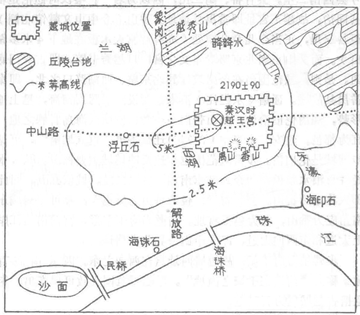 Archaeological site map: location of Yuexiu Hill and ancient city of Nanyue. | The Qin dynasties (beginning in 214 BC) were the beginning of the construction of the ancient city of Guangzhou and the beginning of the construction of Yuexiu Hill by the ancient Guangzhou people. This history laid the foundation for the culture of the Yuexiu Hill: First, the earliest Yuexiu Hill was a place of worship for Nanyue monarchs and ministers; second, Yuexiu Hill was an important water source for the city during the Qin and Han dynasties. Third, Yuexiu Hill was an area for the royal tombs in the Nanyue Kingdom. Since then, Yuexiu Hill has taken on various urban functions and has gradually become an irreplaceable urban heritage composed of multiple values. |
| Sui and Tang Dynasties–Nanhan Dynasties (581–959 A.D) | 30 | 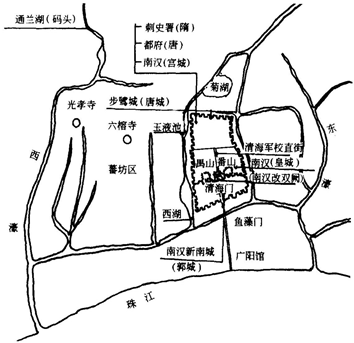 Archaeological site map: location of Yuexiu Hill and ancient city of Tang. | During this period, the spatial extent of Guangzhou City did not remarkably expand, but the functions provided by Yuexiu Hill as a spatial carrier were transformed from their original basis. First, the water system that flows through Yuexiu Hill, in addition to its original function as a water source, was expanded to include navigation and recreational functions. In addition, the construction of religious sites on Yuexiu Hill gradually began during this period. Taoist temples and monasteries such as Yuegang Palaces and Yaoshi Temple were built. During the Nanhan Dynasty, the Yuexiu Hill area was further developed as a royal garden. |
| Song and Yuan Dynasties (960–1367 A.D) | 102 | 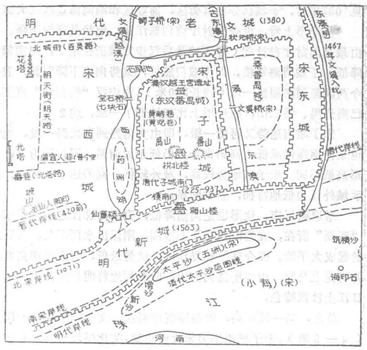 Archaeological site map: location of Yuexiu Hill and ancient city of Song. | The city was extensively expanded to the east and west during this period, but the northern side remained at some distance from Yuexiu Hill. No major construction took place on Yuexiu Hill during this period, and only small and medium religious places of worship were built. Located at the southeastern foot of Yuexiu Hill, Lake Ju was a popular scenic spot during the Song Dynasty, and by the Yuan Dynasty, the lake had been filled in to serve as a field. |
| Ming Dynasty (1368–1615 A.D) | 480 | 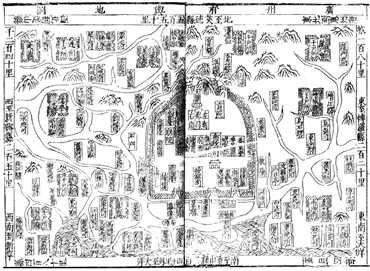 Map of Guangzhou Prefecture, Jiajing period of the Ming Dynasty | The expansion of Guangzhou to the north during this period incorporated part of Yuexiu Hill into the city and was an important point in the development and construction of Yuexiu Hill. The number and variety of construction activities around Yuexiu Hill rapidly increased during this period. In addition to the existing wells and springs and religious sites, people begun to build private gardens, academies, and military facilities at the foot of Yuexiu Hill. During this period, however, the construction of the city also blocked the Wen River, which used to flow through the city. |
| Qing Dynasty (1616–1911 A.D) | 433 | 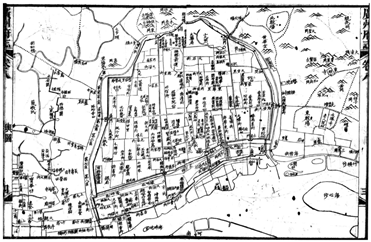 Map of Guangzhou Prefecture, Tongzhi period of the Qing Dynasty | During this period, Yuexiu Hill was the most famous scenic spot in Guangzhou and was known as the main hill of the city. The combination of Yuexiu Hill and Zhenhai Tower became an iconic node in the city’s perception of the ancient city of Guangzhou. A number of study halls, religious buildings, and private gardens were built on the site. At the southern foot of the hill, a series of streets and lanes were built. |
| Republic of China (1912–1949 A.D) | 32 | 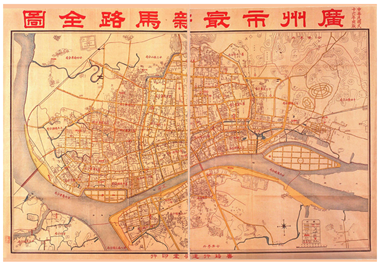 Road Map of Guangzhou in the Republic of China, 1927 | During this period, the walls built on Yuexiu Hill were demolished and incorporated into the city; in 1925, part of Yuexiu Hill was turned into a park, and the streets at its southern foot became denser. |
| Classification of Information Services | Standard Phrase | Original Phrase |
| Social relations | Farewell | 送别 别恨 别离 啼别 |
| Have a conversation | 交谈 言笑 谈笑 坐谈 谈天 谈情 高谈 雄谈 谈禅 谈经 闲谈 聊偃 | |
| Banquet | 宴席 满筵 广宴 席间 溪上席 座上宾 雅集 贤人聚 叙群贤 罗群贤 宴坐 列宴 宴列 宴集 宴会 夜宴 携宾 | |
| Drink | 饮酒 壶觞 酒器 螺杯 酌酒 酒酌 酒气 百杯 樽俎 尊罍 樽罍 杯盘 对饮 酒樽 与君醉 三百杯 衔杯 会饮 醉酒 同醉 白酒 载酒 斗酒 杜陵酒 衔杯 酒酣 小酌 清尊 酒盏 酒社 频传斝 酣饮 对酒 | |
| Having tea | 品茶 茶烹 试茗 茶熟 | |
| Recreation and ecotourism | Hill-climbing | 登高 临高 登临 登赏 登坛 登台 登楼 登城 北眺 晚眺 游眺 下瞰 登垄 凭高 吟眺 |
| Go sightseeing | 游赏 行客 旧游 吟赏 踏青 游居 嬉游 交游 卧游 同游 再游 周游 夜游 游北固 胜游 重游 冶游 追游 邀游 漫游 来游 曾游 | |
| Go fishing | 垂钓 钓鳌 钓鱼 钓矶 钓丝 沉钓 钓著 钓竿 钓罢 | |
| Play music | 奏乐 笙歌 击节 乐声 听笙 鼓声 凤凰箫 音乐 奏乐 携琴 箜篌 丝竹 箫鼓 孤笛 听箫 笙箫 鹤笙 鼓瑟 鸣琴 教人唱 歌钟 | |
| Song and dance | 歌舞 妙舞 醉舞 狂歌 朝歌 舞锦绣 歌还舞 舞蛟 娟舞 采衣舞 清歌妙舞 朝歌暮舞 | |
| Artistic inspiration | Poet | 诗人 诗仙 |
| Compose poems | 赋诗 琼瑰 诗文 笔砚 作诗 著稿 写新诗 诗盟 篇诗 词藻 寄吟 读君诗 旧诗社 觞咏 咏溪山 新诗 佳诗 为此诗 赋诗 越台词社 读君诗 一觞一咏 | |
| Paint a picture | 作画 看画 画苑 画图 听禅图 罨画 画阁 | |
| Calligraphy | 书文 著书 敷文 琴书 读书 著稿 笔谈 | |
| Spiritual and religious | Meditation | 参禅 禅关 了悟 三昧 禅味 成佛 禅灯 禅定 佛骨 佛钵 佛灯 佛光 法性禅心 禅关 |
| Monks | 僧侣 僧少 山僧 胡僧 残僧 一个僧 高僧 野僧 为僧 比丘尼 为尼 老尼 禅师 开士 净侣 | |
| Journey to fairyland | 寻仙 仙去 仙游 仙炼 仙仗 迎仙 求仙 仙迹 仙踪 | |
| Wonderland | 仙境 仙乡 仙窟 仙室 仙都 仙已去 仙石 仙树 仙杏 蓬岛 仙岛 仙圃 仙侣 仙宅 仙家 仙城 上方 仙界 玉京 瀛洲 蓬莱 | |
| Fairies | 仙灵 仙翁 仙人 仙子 仙姑 羊石仙踪 五仙 苏仙 歌仙 鹤仙 谪仙 神仙 仙客 五穗仙人 三元大帝 仙羊 北斗 衔穗仙人 五色仙禽 郑仙 | |
| Sages | 圣贤 拜坡仙 鲍姑 苏子 先贤 | |
| Worship | 祭拜 哭祭 祠祀 祠前 | |
| Education | Classical academy | 书院 学堂 讲堂 |
| Academic studies | 致学 还以古籍授 绎史诵经 著书 新学 读书 学文术 论学 劝学 督学 讲学 学业 | |
| Gifted scholar | 人才 群贤 大儒 群英 科名 才子 | |
| Aesthetic | - | - |
| Cultural memory | Nostalgia | 怀古 吊古 凭吊 咏怀 咏史 霸业 |
| Past events | 往事 旧时 千古 当年 兴亡 前朝 回首 昔年 | |
| Festival | 佳节 | |
| Pure Brightness | 清明 | |
| Cold Food Day | 寒食 | |
| The Double Ninth Festival | 重阳 萸囊 菊酒 花糕 萸酒 | |
| The Lantern Festival | 元夕 元宵节 | |
| Worship the kitchen god | 祀灶 | |
| Shangsi Festival | 上巳 祓禊 修禊 | |
| Fly kite | 纸鸢 | |
| Dragon Boat Festival | 端午 端阳 龙舟 |
| ID | Phrase | f | ID | Phrase | f | ID | Phrase | f | ID | Phrase | f |
| (I) Land Cover | |||||||||||
| Study area | (8) | Field | 55 | (16) | Range | 12 | (6) | South Sea | 29 | ||
| (1) | Forests | 190 | (9) | Islet | 55 | (17) | Waterfall | 4 | (7) | Central Plains | 28 |
| (2) | Lake | 133 | (10) | Hole | 38 | Associated Regions | (8) | Five Ridges | 25 | ||
| (3) | Ridge | 118 | (11) | Gully | 31 | (1) | City | 112 | (9) | Imperial capital | 22 |
| (4) | Spring | 112 | (12) | Cliff | 22 | (2) | Pearl River | 85 | (10) | Panyu | 17 |
| (5) | Peak | 88 | (13) | Okan | 22 | (3) | Mountains | 44 | (11) | Shimen | 15 |
| (6) | Creek | 69 | (14) | Streams | 17 | (4) | Guangzhou | 42 | (12) | the Three Hills | 13 |
| (7) | Clear spring | 56 | (15) | Pond | 17 | (5) | Sea | 31 | (13) | City of Goats | 12 |
| (II) Natural Ecological Elements | |||||||||||
| Plant species | (34) | Huang Mei | 2 | (1) | Tiger | 40 | (32) | Crab | 3 | ||
| (1) | Plum blossom | 41 | (35) | Orchid | 2 | (2) | Horse | 27 | Fish | ||
| (2) | Pine Tree | 37 | (36) | Brasenia schreberi | 2 | (3) | Domestic animals | 24 | (33) | Carp | 3 |
| (3) | Bamboo | 35 | (37) | Holly | 2 | (4) | Ape | 10 | (34) | Whitebait | 1 |
| (4) | Lychee | 34 | (38) | Bodhi | 2 | (5) | Rabbit | 9 | Insects | ||
| (5) | Kapok | 29 | (39) | Red bayberry | 2 | (6) | Leopard | 5 | (35) | Butterfly | 9 |
| (6) | Willow | 26 | (40) | Frangipani | 2 | (7) | Elk | 3 | (36) | The Cicada | 8 |
| (7) | Hibiscus | 19 | (41) | Sweet-scented osmanthus | 2 | (8) | Rat | 2 | (37) | Silkworm | 6 |
| (8) | Chinese hibiscus | 14 | (42) | Livistona chinensis | 1 | (9) | Wolf | 2 | (38) | Cricket | 2 |
| (9) | Peach blossom | 11 | (43) | Acacia | 1 | (10) | Bat | 1 | (39) | Snail | 1 |
| (10) | Banyan tree | 10 | (44) | Orange Grove | 1 | Birds | (40) | Dragonfly | 1 | ||
| (11) | Maple tree | 10 | (45) | Pawpaw | 1 | (11) | Wild Goose | 57 | (41) | Fireflies | 2 |
| (12) | Calamus | 10 | (46) | Yulan | 1 | (12) | Partridge | 48 | (42) | Spider | 1 |
| (13) | Moss | 10 | (47) | Apricot | 1 | (13) | Warbler | 27 | (43) | Bee | 1 |
| (14) | Chrysanthemum | 9 | (48) | Rattan | 1 | (14) | Swallow | 24 | (44) | Grub | 1 |
| (15) | Lotus | 8 | (49) | Chinese tallow tree | 1 | (15) | Crane | 21 | Natural Meteorology | ||
| (16) | Ficus pumila | 8 | (50) | Elm forest | 1 | (16) | Crow | 12 | (1) | Clouds | 161 |
| (17) | Peaches and plums | 7 | (51) | Coconut | 1 | (17) | Gulls | 11 | (2) | Smoke | 98 |
| (18) | Jasmine | 6 | (52) | Apricot blossom | 1 | (18) | Egret | 7 | (3) | Rain | 68 |
| (19) | Mulan | 5 | (53) | Alfalfa | 1 | (19) | Cuckoo | 9 | (4) | Sunglow | 67 |
| (20) | Betelnut | 5 | (54) | Reed flower | 1 | (20) | Parrot | 4 | (5) | Spring breeze | 56 |
| (21) | Poplar | 5 | (55) | Hemerocallis | 1 | (21) | Petrel | 3 | (6) | Autumn wind | 47 |
| (22) | Nang | 5 | (56) | Toon tree | 1 | (22) | Wild duck | 2 | (7) | Cold wind | 16 |
| (23) | Jasmine | 5 | (57) | Peony | 1 | (23) | Magpie | 2 | (8) | Autumn rain | 12 |
| (24) | Rose | 4 | (58) | Rice | 1 | (24) | Goshawk | 2 | (9) | Spring Rain | 6 |
| (25) | Pear blossom | 4 | (59) | Plantain | 1 | (25) | Oriole | 1 | (10) | Thunderstorm | 6 |
| (26) | Lotus | 4 | (60) | Lagerstroemia indica | 1 | (26) | White pheasant | 1 | (11) | Typhoon | 1 |
| (27) | The locust tree | 4 | (61) | Wisteria | 1 | (27) | Bird of prey | 1 | (12) | Frost and dew | 1 |
| (28) | Rose | 4 | (62) | Phoenix flower | 1 | (28) | Stork | 1 | Celestial objects | ||
| (29) | Flower of Polygonum | 3 | (63) | Cherry | 1 | Amphibians | (1) | Moon | 118 | ||
| (30) | Ficus pumila | 3 | (64) | Pomegranate | 1 | (29) | Crocodile | 3 | (2) | Sunset | 91 |
| (31) | Syzygium jambos | 3 | (65) | Lentinus edodes | 1 | (30) | Frog | 2 | (3) | Stars | 37 |
| (32) | Begonia | 3 | Animal species | Arthropods | (4) | Sunshine | 4 | ||||
| (33) | Red Bean | 2 | Mammals | (31) | Shrimp | 6 | (5) | Solar eclipse | 1 | ||
| (III) Cultural Elements | |||||||||||
| Historic sites | (18) | Taiquan Academy | 1 | (7) | Garden | 20 | (25) | Battery | 1 | ||
| (1) | Yuewang Platform | 433 | (19) | North Garden | 1 | (8) | Vihara | 15 | (26) | Bookstore | 1 |
| (2) | Chaohan Platform | 101 | (20) | Xuehaitang Academy | 12 | (9) | Academies | 13 | (27) | Monk’s house | 1 |
| (3) | Yuewang Well | 54 | (21) | Zhaozhong Ancestral Hall | 8 | (10) | Relic | 12 | Historic figures | ||
| (4) | Yuewang Tomb | 1 | (22) | Yingyuan Academy | 5 | (11) | Palace | 11 | (1) | King of Yue (Wei Tuo) | 101 |
| (5) | Huluan Path | 26 | (23) | Yixiu Garden | 2 | (12) | Ancient Tomb | 9 | (2) | Bao Gu | 38 |
| (6) | Wanggu Nunnery | 17 | (24) | Hongmian Temple | 2 | (13) | Pavilion | 7 | (3) | Lu Jia | 24 |
| (7) | Sanyuan Taoist Palaces | 14 | (25) | Ji Garden | 5 | (14) | Cottage | 6 | (4) | the Five Goats | 23 |
| (8) | Guanyin Pavilion | 7 | (26) | Jupo Academy | 1 | (15) | Battlement | 5 | (5) | Ren Xiao | 13 |
| (9) | Jiao Platform | 4 | (27) | Other Gardens | 16 | (16) | Stone building | 5 | (6) | Jingwei | 5 |
| (10) | Xizhu Temple | 1 | (28) | Other Academies | 11 | (17) | Red chamber | 4 | (7) | Xuan yuan | 5 |
| (11) | Zhenhai Tower | 131 | Artificial elements | (18) | Ancient temple | 4 | (8) | Emperor Wu | 3 | ||
| (12) | Sanjun Ancestral Hall | 8 | (1) | High-rise | 92 | (19) | Road | 3 | (9) | Ruan Ji | 3 |
| (13) | Weituo Tower | 6 | (2) | Hut | 28 | (20) | Red Wall | 3 | (10) | Han Yu | 3 |
| (14) | Xieyan Spring | 2 | (3) | High Platform | 28 | (21) | Ancient well | 3 | (11) | Emperor Qin | 2 |
| (15) | Banshan Pavilion | 2 | (4) | Hill house | 24 | (22) | Circular Mound | 2 | (12) | Jia Yi | 1 |
| (16) | Bushi Nunnery | 2 | (5) | Ancient road | 21 | (23) | Path | 2 | (13) | Diao Chan | 1 |
| (17) | Wanli Bridge | 1 | (6) | Railings | 20 | (24) | Meditation room | 1 | (14) | Emperor Yang | 1 |
| Historic Sites | Artificial Elements | Historic Figures | Natural Meteorology | Celestial Objects | Animal Species | Plant Species | Waterscape Elements | Associated Regions | ||||||||||
| IS | Elements | w | Elements | w | Elements | w | Elements | w | Elements | w | Elements | w | Elements | w | Elements | w | Elements | w |
| Social relations | Yuewang Platform | 178 | High-rise | 38 | King of Yue | 34 | Clouds | 86 | Moon | 76 | Steed | 26 | Plum blossom | 54 | Clear spring | 18 | City | 66 |
| Chaohan Platform | 56 | Hut | 32 | the Five Goats | 14 | Smoke | 80 | Sunset | 42 | Partridge | 24 | Lychee | 28 | Clear spring | 16 | Sea | 56 | |
| Zhenhai Tower | 48 | Hill house | 20 | Lu Jia | 14 | Sunglow | 44 | Stars | 24 | Warbler | 24 | Willow | 18 | Stream | 16 | Pearl River | 56 | |
| Weituo Tower | 28 | Railings | 12 | Ren Xiao | 10 | Rain | 48 | Sunset | 18 | Dragon | 20 | Bamboo | 18 | Running water | 12 | Luofu Hill | 30 | |
| Yuewang Well | 16 | Ancient road | 8 | Wei Tuo | 6 | Spring breeze | 44 | Wild Goose | 20 | Pine Tree | 16 | Mountain Stream | 6 | Five Ridges | 26 | |||
| Huluan Path | 14 | Deserted platform | 2 | Autumn wind | 32 | Swallow | 16 | Kapok | 6 | Running water | 2 | Imperial capital | 20 | |||||
| Taiquan Academy | 10 | Gentle breeze | 12 | Domestic animals | 10 | Chinese hibiscus | 6 | the Three Hills | 18 | |||||||||
| Xuehaitang Academy | 6 | Cold wind | 12 | Crane | 10 | Hibiscus | 4 | Guangzhou | 18 | |||||||||
| Liuhua Bridge | 4 | The wind blows | 8 | Insect | 8 | South Sea | 18 | |||||||||||
| Central Plains | 18 | |||||||||||||||||
| Baiyue | 10 | |||||||||||||||||
| Panyu | 10 | |||||||||||||||||
| Shimen | 10 | |||||||||||||||||
| WSR-j | 360 | 112 | 78 | 366 | 160 | 158 | 176 | 70 | 472 | |||||||||
| Recreation and ecotourism | Yuewang Platform | 346 | High-rise | 42 | Wei Tuo | 32 | Clouds | 206 | Moon | 152 | Partridge | 60 | Kapok | 74 | Stream | 48 | City | 170 |
| Zhenhai Tower | 162 | Hut | 42 | the Five Goats | 34 | Smoke | 160 | Sunset | 98 | Horse | 56 | Lychee | 62 | Zhilan Lake | 42 | Sea | 146 | |
| Chaohan Platform | 120 | High-rise | 74 | Lu Jia | 18 | Sunglow | 108 | Stars | 64 | Warbler | 44 | Plum blossom | 52 | Clear spring | 32 | Pearl River | 112 | |
| Huluan Path | 68 | Railings | 42 | Ren Xiao | 12 | Rain | 90 | Sunset | 36 | Wild Goose | 36 | Hibiscus | 40 | Mountain Stream | 14 | Luofu Hill | 68 | |
| Xuehaitang Academy | 26 | Ancient road | 34 | King of Yue | 18 | Spring breeze | 76 | Swallow | 34 | Pine Tree | 36 | Running water | 2 | Five Ridges | 60 | |||
| Liuhua Bridge | 26 | Hill house | 32 | Autumn wind | 64 | Dragon | 28 | Willow | 36 | Baiyue | 52 | |||||||
| Yuewang Well | 24 | Deserted platform | 24 | Gentle breeze | 28 | Domestic animals | 22 | Chinese hibiscus | 24 | Central Plains | 42 | |||||||
| Weituo Tower | 20 | High Platform | 22 | Cold wind | 22 | Crane | 20 | Bamboo | 20 | Guangzhou | 40 | |||||||
| Qingquan Academy | 8 | At the door | 8 | The wind blows | 18 | Pine Tree | 14 | Imperial capital | 34 | |||||||||
| Shimen | 28 | |||||||||||||||||
| Panyu | 24 | |||||||||||||||||
| the Three Hills | 16 | |||||||||||||||||
| South Sea | 16 | |||||||||||||||||
| WRE-j | 800 | 338 | 114 | 772 | 350 | 300 | 426 | 138 | 998 | |||||||||
| Artistic inspiration | Yuewang Platform | 54 | High-rise | 12 | King of Yue | 8 | Clouds | 28 | Moon | 32 | Wild Goose | 6 | Lychee | 12 | Clear spring | 6 | City | 20 |
| Zhenhai Tower | 10 | Hut | 6 | Wei Tuo | 2 | Smoke | 22 | Stars | 14 | Partridge | 10 | Chinese hibiscus | 12 | Zhilan Lake | 4 | Pearl River | 18 | |
| Chaohan Platform | 22 | Hill house | 6 | the Five Goats | 8 | Sunglow | 14 | Sunset | 10 | Dragon | 6 | Hibiscus | 10 | Stream | 10 | Sea | 12 | |
| Yuewang Well | 10 | Ancient road | 4 | Liu Jia | 6 | Spring breeze | 14 | Sunset | 4 | Warbler | 2 | Pine Tree | 8 | Mountain Stream | 4 | Shimen | 12 | |
| Huluan Path | 6 | Deserted platform | 2 | Ren Xiao | 4 | Autumn wind | 12 | Horse | 8 | Willow | 4 | Five Ridges | 10 | |||||
| Xuehaitang Academy | 2 | Rain | 16 | Crane | 8 | Plum blossom | 2 | Luofu Hill | 10 | |||||||||
| Weituo Tower | 2 | Gentle breeze | 4 | Domestic animals | 4 | Pearl River | 10 | |||||||||||
| The wind blows | 4 | Swallow | 4 | Baiyue | 10 | |||||||||||||
| Imperial capital | 6 | |||||||||||||||||
| South Sea | 4 | |||||||||||||||||
| WAI-j | 106 | 42 | 28 | 114 | 60 | 48 | 58 | 24 | 140 | |||||||||
| Spiritual and religious values | Yuewang Platform | 168 | High-rise | 86 | the Five Goats | 26 | Clouds | 164 | Moon | 116 | Horse | 36 | Lychee | 48 | Clear spring | 42 | Sea | 110 |
| Zhenhai Tower | 84 | Hut | 16 | King of Yue | 16 | Smoke | 86 | Stars | 68 | Dragon | 28 | Plum blossom | 40 | Stream | 26 | City | 86 | |
| Chaohan Platform | 86 | Railings | 16 | Lu Jia | 14 | Sunglow | 72 | Sunset | 58 | Crane | 22 | Chinese hibiscus | 40 | Mountain Stream | 20 | Luofu Hill | 80 | |
| Huluan Path | 24 | Hill house | 12 | King of Yue | 14 | Rain | 68 | Sunset | 20 | Partridge | 20 | Pine Tree | 24 | Zhilan Lake | 16 | Pearl River | 62 | |
| Yuewang Well | 14 | High Platform | 8 | Wei Tuo | 10 | Spring breeze | 36 | Wild Goose | 14 | Bamboo | 14 | Running water | 12 | Five Ridges | 28 | |||
| Liuhua Bridge | 6 | Deserted platform | 8 | Autumn wind | 34 | Warbler | 14 | Willow | 14 | Luofu Hill | 22 | |||||||
| Weituo Tower | 6 | At the door | 2 | Gentle breeze | 12 | Domestic animals | 12 | Kapok | 10 | South of the five ranges | 18 | |||||||
| Wanggu Nunnery | 6 | The wind blows | 8 | Swallow | 8 | Hibiscus | 10 | Shimen | 16 | |||||||||
| Xuehaitang Academy | 4 | Central Plains | 14 | |||||||||||||||
| Weituo Tower | 2 | Baiyue | 12 | |||||||||||||||
| Qingquan Academy | 2 | South Sea | 8 | |||||||||||||||
| Panyu | 6 | |||||||||||||||||
| WS&R-j | 402 | 148 | 80 | 494 | 262 | 154 | 258 | 116 | 592 | |||||||||
| Education | Yuewang Platform | 18 | Hut | 2 | the Five Goats | 4 | Spring breeze | 10 | Moon | 8 | Wild Goose | 8 | Plum blossom | 10 | Zhilan Lake | 6 | Guangzhou | 10 |
| Zhenhai Tower | 4 | High-rise | 2 | King of Yue | 2 | Autumn wind | 6 | Sunset | 4 | Partridge | 8 | Lychee | 4 | Mountain Stream | 4 | City | 8 | |
| Chaohan Platform | 10 | Railings | 2 | Wei Tuo | 2 | Rain | 4 | Stars | 2 | Horse | 2 | Kapok | 4 | Baiyue | 6 | |||
| Yuewang Well | 6 | High Platform | 2 | Clouds | 4 | Swallow | 4 | Chinese hibiscus | 2 | Sea | 4 | |||||||
| Huluan Path | 4 | Ancient road | 2 | Smoke | 4 | Willow | 2 | South Sea | 4 | |||||||||
| Liuhua Bridge | 2 | Central Plains | 4 | |||||||||||||||
| Qingquan Academy | 2 | Five Ridges | 4 | |||||||||||||||
| Xuehaitang Academy | 6 | Imperial capital | 4 | |||||||||||||||
| Weituo Tower | 2 | Shimen | 4 | |||||||||||||||
| Pearl River | 2 | |||||||||||||||||
| Luofu Hill | 2 | |||||||||||||||||
| WE-j | 54 | 10 | 8 | 28 | 14 | 22 | 24 | 10 | 58 | |||||||||
| Cultural memory | Yuewang Platform | 196 | High-rise | 30 | King of Yue | 28 | Clouds | 86 | Moon | 66 | Partridge | 36 | Plum blossom | 26 | Clear spring | 10 | Sea | 66 |
| Zhenhai Tower | 36 | Hill house | 22 | Wei Tuo | 18 | Smoke | 76 | Sunset | 66 | Dragon | 20 | Lychee | 22 | Mountain Stream | 10 | City | 64 | |
| Chaohan Platform | 60 | Deserted platform | 22 | Lu Jia | 6 | Spring breeze | 54 | Stars | 34 | Warbler | 22 | Plum blossom | 20 | Clear spring | 8 | Pearl River | 50 | |
| Huluan Path | 22 | Hut | 18 | Ren Xiao | 4 | Sunglow | 40 | Sunset | 6 | Horse | 18 | Hibiscus | 14 | Stream | 8 | Central Plains | 40 | |
| Liuhua Bridge | 16 | High Platform | 8 | the Five Goats | 4 | Autumn wind | 36 | Wild Goose | 18 | Kapok | 10 | Zhilan Lake | 4 | Luofu Hill | 26 | |||
| Yuewang Well | 4 | Railings | 6 | Rain | 44 | Swallow | 14 | Bamboo | 10 | Running water | 4 | Shimen | 24 | |||||
| Wanggu Nunnery | 2 | Ancient road | 4 | Cold wind | 4 | Domestic animals | 6 | Pine Tree | 6 | Five Ridges | 24 | |||||||
| Xuehaitang Academy | 2 | The wind blows | 4 | Wild Goose | 4 | Willow | 4 | Guangzhou | 20 | |||||||||
| Weituo Tower | 2 | Imperial capital | 14 | |||||||||||||||
| Baiyue | 4 | |||||||||||||||||
| Panyu | 4 | |||||||||||||||||
| South Sea | 4 | |||||||||||||||||
| WCM-j | 340 | 110 | 60 | 344 | 172 | 138 | 160 | 44 | 438 | |||||||||
| Wj | 2062 | 760 | 368 | 2118 | 1018 | 820 | 1102 | 402 | 2698 | |||||||||
| Wij (weight): sum of the weights of the links between element phrase j and service phrase i. Wj: sum of the weights of the links between element phrase j and all service phrases. (i = SR, RE, AI, S and R, E, and CM; j = historic sites, artificial elements, historic figures, natural meteorology, celestial objects, animal species, plant species, waterscape elements, and associated regions). | ||||||||||||||||||
References
- Wang, X. Ten Points of Advocacies of Urban Nature. Chin. Landsc. Archit. 2021, 37, 2–3. [Google Scholar]
- Olivadese, M.; Dindo, M.L. Historic and Contemporary Gardens: A Humanistic Approach to Evaluate Their Role in Enhancing Cultural, Natural and Social Heritage. Land 2022, 11, 2214. [Google Scholar] [CrossRef]
- Zhang, Z.; Ye, B. Forest Therapy in Germany, Japan, and China: Proposal, Development Status, and Future Prospects. Forests 2022, 13, 1289. [Google Scholar] [CrossRef]
- Lee, S.-H.; Chu, Y.-C.; Kung, P.-C. Taiwan’s Forest from Environmental Protection to Well-Being: The Relationship between Ecosystem Services and Health Promotion. Forests 2022, 13, 709. [Google Scholar] [CrossRef]
- Allard-Poesi, F.; Matos, L.B.S.; Massu, J. Not all types of nature have an equal effect on urban residents’ well-being: A structural equation model approach. Health Place 2022, 74, 102759. [Google Scholar] [CrossRef]
- Lopez Sanchez, M.; Tejedor Cabrera, A.; Gomez del Pulgar, M.L. The potential role of cultural ecosystem services in heritage research through a set of indicators. Ecol. Indic. 2020, 117, 106670. [Google Scholar] [CrossRef]
- Baumeister, C.F.; Gerstenberg, T.; Plieninger, T.; Schraml, U. Exploring cultural ecosystem service hotspots: Linking multiple urban forest features with public participation mapping data. Urban For. Urban Green. 2020, 48, 126561. [Google Scholar] [CrossRef]
- Cheng, X.; Van Damme, S.; Uyttenhove, P. A review of empirical studies of cultural ecosystem services in urban green infrastructure. J. Environ. Manag. 2021, 293, 112895. [Google Scholar] [CrossRef]
- Gómez-Baggethun, E.; de Groot, R.; Lomas, P.L.; Montes, C. The history of ecosystem services in economic theory and practice: From early notions to markets and payment schemes. Ecol. Econ. 2010, 69, 1209–1218. [Google Scholar] [CrossRef]
- Daily, G.C.; Polasky, S.; Goldstein, J.; Kareiva, P.M.; Mooney, H.A.; Pejchar, L.; Ricketts, T.H.; Salzman, J.; Shallenberger, R. Ecosystem services in decision making: Time to deliver. Front. Ecol. Environ. 2009, 7, 21–28. [Google Scholar] [CrossRef]
- Plieninger, T.; Dijks, S.; Oteros-Rozas, E.; Bieling, C. Assessing, mapping, and quantifying cultural ecosystem services at community level. Land Use Policy 2013, 33, 118–129. [Google Scholar] [CrossRef]
- Kirchhoff, T. Abandoning the Concept of Cultural Ecosystem Services, or Against Natural-Scientific Imperialism. Bioscience 2019, 69, 220–227. [Google Scholar] [CrossRef]
- Cheng, X.; Van Damme, S.; Li, L.; Uyttenhove, P. Evaluation of cultural ecosystem services: A review of methods. Ecosyst. Serv. 2019, 37, 100925. [Google Scholar] [CrossRef]
- Cardoso, A.S.; Renna, F.; Moreno-Llorca, R.; Alcaraz-Segura, D.; Tabik, S.; Ladle, R.J.; Sofia Vaz, A. Classifying the content of social media images to support cultural ecosystem service assessments using deep learning models. Ecosyst. Serv. 2022, 54, 101410. [Google Scholar] [CrossRef]
- Kothencz, G.; Kolcsar, R.; Cabrera-Barona, P.; Szilassi, P. Urban Green Space Perception and Its Contribution to Well-Being. Int. J. Environ. Res. Public Health 2017, 14, 766. [Google Scholar] [CrossRef]
- You, S.; Zheng, Q.; Chen, B.; Xu, Z.; Lin, Y.; Gan, M.; Zhu, C.; Deng, J.; Wang, K. Identifying the spatiotemporal dynamics of forest ecotourism values with remotely sensed images and social media data: A perspective of public preferences. J. Clean. Prod. 2022, 341, 130715. [Google Scholar] [CrossRef]
- Dai, P.; Zhang, S.; Chen, Z.; Gong, Y.; Hou, H. Perceptions of Cultural Ecosystem Services in Urban Parks Based on Social Network Data. Sustainability 2019, 11, 5386. [Google Scholar] [CrossRef]
- Jiang, W.; Marggraf, R. Ecosystems in Books: Evaluating the Inspirational Service of the Weser River in Germany. Land 2021, 10, 669. [Google Scholar] [CrossRef]
- Katayama, N.; Baba, Y.G. Measuring artistic inspiration drawn from ecosystems and biodiversity: A case study of old children’s songs in Japan. Ecosyst. Serv. 2020, 43, 101116. [Google Scholar] [CrossRef]
- Lee, J.-H.; Park, H.-J.; Kim, I.; Kwon, H.-S. Analysis of cultural ecosystem services using text mining of residents’ opinions. Ecol. Indic. 2020, 115, 106368. [Google Scholar] [CrossRef]
- Hirahara, S. Evaluation of a Structure Providing Cultural Ecosystem Services in Forest Recreation: Quantitative Text Analysis of Essays by Participants. Forests 2021, 12, 1546. [Google Scholar] [CrossRef]
- Ruedisser, J.; Schirpke, U.; Tappeiner, U. Symbolic entities in the European Alps: Perception and use of a cultural ecosystem service. Ecosyst. Serv. 2019, 39, 100980. [Google Scholar] [CrossRef]
- De Groot, R.S.; Wilson, M.A.; Boumans, R.M.J. A typology for the classification, description and valuation of ecosystem functions, goods and services. J. Ecol. Econ. 2002, 41, 393–408. [Google Scholar] [CrossRef]
- Costanza, R.; d’Arge, R.; de Groot, R.; Farber, S.; Grasso, M.; Hannon, B.; Limburg, K.; Naeem, S.; O’Neil, R.V.; Paruelo, J.; et al. The value of the world’s ecosystem services and natural capital. Nature 1997, 387, 253–260. [Google Scholar] [CrossRef]
- De Groot, R.S.; Spellergerg, I.F. Functions of Nature: Evaluation of nature in environmental planning, management and decision making. J. Environ. Values 1993, 2, 274–276. [Google Scholar]
- Shannon, C.E. A Mathematical Theory of Communication. Bell Labs Tech. J. 1948, 27, 379–423. [Google Scholar] [CrossRef]
- Termorshuizen, J.W.; Opdam, P. Landscape services as a bridge between landscape ecology and sustainable development. Landsc. Ecol. 2009, 24, 1037–1052. [Google Scholar] [CrossRef]
- Millennium Ecosystem Assessment. Ecosystems and Human Well-Being: Synthesis; Island Press: Washington, DC, USA, 2005; Volume 2022. [Google Scholar]
- Feng, P.Z. Yuexiu Hill of the Thousand Years; Guangdong People’s Publishing House: Guangzhou, China, 2018; p. 273. [Google Scholar]
- Hermann, A.; Kuttner, M.; Hainz-Renetzeder, C.; Konkoly-Gyuró, É.; Tirászi, Á.; Brandenburg, C.; Allex, B.; Ziener, K.; Wrbka, T. Assessment framework for landscape services in European cultural landscapes: An Austrian Hungarian case study. Ecol. Indic. 2014, 37, 229–240. [Google Scholar] [CrossRef]
- Schaich, H.; Bieling, C.; Plieninger, T. Linking Ecosystem Services with Cultural Landscape Research. GAIA Ecol. Perspect. Sci. Soc. 2010, 19, 269–277. [Google Scholar] [CrossRef]
- De Groot, R.S.; Alkemade, R.; Braat, L.; Hein, L.; Willemen, L. Challenges in integrating the concept of ecosystem services and values in landscape planning, management and decision making. Ecol. Complex. 2010, 7, 260–272. [Google Scholar] [CrossRef]
- Quillian, M.R. Semantic Information Processing; MIT Press: Cambridge, MA, USA, 1968; p. 440. [Google Scholar]
- Dong, J.; Wang, Y.; Yu, R. Application of the Semantic Network Method to Sightline Compensation Analysis of the Humble Administrator’s Garden. Nexus Netw. J. 2020, 23, 209–225. [Google Scholar] [CrossRef]
- Dong, J.; Zou, G.; Qi, L. Urban Design Logical Scheming Based on Semantic Network Information. Inf. Technol. J. 2013, 12, 5725–5730. [Google Scholar] [CrossRef]
- Robert, S. Encyclopedia of Artificial Intelligence; John Wiley & Sons, Inc.: New York, NY, USA, 1987; p. 1219. [Google Scholar]
- Butts, C.T. Social network analysis: A methodological introduction. Asian J. Soc. Psychol. 2008, 11, 13–41. [Google Scholar] [CrossRef]
- Garton, L.; Haythornthwaite, C.; Wellman, B. Studying Online Social Networks. J. Comput. Commun. 1997, 3. [Google Scholar] [CrossRef]
- Jessel, B. Elements, characteristics and character—Information functions of landscapes in terms of indicators. Ecol. Indic. 2006, 6, 153–167. [Google Scholar] [CrossRef]
- Scholte, S.S.K.; van Teeffelen, A.J.A.; Verburg, P.H. Integrating socio-cultural perspectives into ecosystem service valuation: A review of concepts and methods. Ecol. Econ. 2015, 114, 67–78. [Google Scholar] [CrossRef]
- Chan, K.M.; Satterfield, T.; Goldstein, J. Rethinking ecosystem services to better address and navigate cultural values. Ecol. Econ. 2012, 74, 8–18. [Google Scholar] [CrossRef]
- Tenerelli, P.; Demsar, U.; Luque, S. Crowdsourcing indicators for cultural ecosystem services: A geographically weighted approach for mountain landscapes. Ecol. Indic. 2016, 64, 237–248. [Google Scholar] [CrossRef]
- Wang, Y.; Shi, X.; Cheng, K.; Zhang, J.; Chang, Q. How do urban park features affect cultural ecosystem services: Quantified evidence for design practices. Urban For. Urban Green. 2022, 76, 127713. [Google Scholar] [CrossRef]
- Engelhardt, R.A.; Rogers, P.R. Hoi An Protocols for Best Conservation Practice in Asia: Professional Guidelines for Assuring and Preserving the Authenticity of Heritage Sites in the Context of the Cultures of Asia; UNESCO: Bangkok, Thailand, 2009. [Google Scholar]
- Jaworski, A. Semiotic Landscapes:Language, Image, Space; Continuum International Publishing Group Limited: London, UK, 2010; p. 272. [Google Scholar]
- Demaj, U. Symbolic identity building, ethnic nationalism and the linguistic reconfiguration of the urban spaces of the capital of Pristina, Kosovo. Ethnicities 2022, 1–23. [Google Scholar] [CrossRef]
- Manuel, C. The Power of Identity: The Information Age—Economy, Society, and Culture; Wiley: New York, NY, USA, 2011; p. 584. [Google Scholar]
- Forristal, L.J.; Lehto, X.Y.; Lee, G. The contribution of native species to sense of place. Curr. Issues Tour. 2012, 17, 414–433. [Google Scholar] [CrossRef]
- Bromley, R. Placing Animals: An Introduction to the Geography of Human–Animal Relations. AAG Rev. Books 2014, 2, 133–135. [Google Scholar] [CrossRef]
- Schirpke, U.; Meisch, C.; Tappeiner, U. Symbolic species as a cultural ecosystem service in the European Alps: Insights and open issues. Landsc. Ecol. 2018, 33, 711–730. [Google Scholar] [CrossRef]
- Osawa, T.; Ueno, Y.; Nishida, T.; Nishihiro, J. Do both habitat and species diversity provide cultural ecosystem services? A trial using geo-tagged photos. Nat. Conserv. 2020, 38, 61–77. [Google Scholar] [CrossRef]
- McGinlay, J.; Parsons, D.J.; Morris, J.; Hubatova, M.; Graves, A.; Bradbury, R.B.; Bullock, J.M. Do charismatic species groups generate more cultural ecosystem service benefits? Ecosyst. Serv. 2017, 27, 15–24. [Google Scholar] [CrossRef]
- Lowenthal, J.; Gerecht, S. If You Build It, They Will Come? Circ. Res. 2020, 127, 225–228. [Google Scholar] [CrossRef]
- Agimass, F.; Lundhede, T.; Panduro, T.E.; Jacobsen, J.B. The choice of forest site for recreation: A revealed preference analysis using spatial data (Article). Ecosyst. Serv. 2018, 31, 445–454. [Google Scholar] [CrossRef]
- ICOMOS. The ICOMOS Charter for the Interpretation and Presentation of Cultural Heritage Sites. In Proceedings of the 16th General Assembly of ICOMOS, Québec, QC, Canada, 4 October 2008; p. 8. [Google Scholar]
- Hegetschweiler, K.T.; de Vries, S.; Arnberger, A.; Bell, S.; Brennan, M.; Siter, N.; Olafsson, A.S.; Voigt, A.; Hunziker, M. Linking demand and supply factors in identifying cultural ecosystem services of urban green infrastructures: A review of European studies. Urban For. Urban Green. 2017, 21, 48–59. [Google Scholar] [CrossRef]
- Tedeschi, M.; Heino, H.; Jämsä, J.; Klemettilä, A. The multidimensionality of urban nature: The well-being and integration of immigrants in Finland. Urban For. Urban Green. 2022, 74, 127645. [Google Scholar] [CrossRef]
- Nita, M.R.; Loja, C. Environmental Conflicts in the Context of the Challenging Urban Nature. Carpathian J. Earth Environ. Sci. 2020, 15, 471–479. [Google Scholar] [CrossRef]
- Tenerelli, P.; Püffel, C.; Luque, S. Spatial assessment of aesthetic services in a complex mountain region: Combining visual landscape properties with crowdsourced geographic information. Landsc. Ecol. 2017, 32, 1097–1115. [Google Scholar] [CrossRef]
- Dabaut, N.; Carrer, F. Historic Landscape Characterisation: Technical Approaches Beyond Theory. Landscapes 2021, 21, 152–167. [Google Scholar] [CrossRef]
- Last, J. Hidden Landscape Characterisation: Some Thoughts on the Relationship of HLC to Archaeological Data. Landscapes 2021, 21, 135–151. [Google Scholar] [CrossRef]
- De Valck, J.; Broekx, S.; Liekens, I.; De Nocker, L.; Van Orshoven, J.; Vranken, L. Contrasting collective preferences for outdoor recreation and substitutability of nature areas using hot spot mapping. Landsc. Urban Plan. 2016, 151, 64–78. [Google Scholar] [CrossRef]
- Cusens, J.; Barraclough, A.M.D.; Måren, I.E. Participatory mapping reveals biocultural and nature values in the shared landscape of a Nordic UNESCO Biosphere Reserve. People Nat. 2021, 4, 365–381. [Google Scholar] [CrossRef]
- Ghermandi, A.; Camacho-Valdez, V.; Trejo-Espinosa, H. Social media-based analysis of cultural ecosystem services and heritage tourism in a coastal region of Mexico. Tour. Manag. 2020, 77, 104002. [Google Scholar] [CrossRef]
- Fagerholm, N.; Käyhkö, N.; Ndumbaro, F.; Khamis, M. Community stakeholders’ knowledge in landscape assessments—Mapping indicators for landscape services. Ecol. Indic. 2012, 18, 421–433. [Google Scholar] [CrossRef]

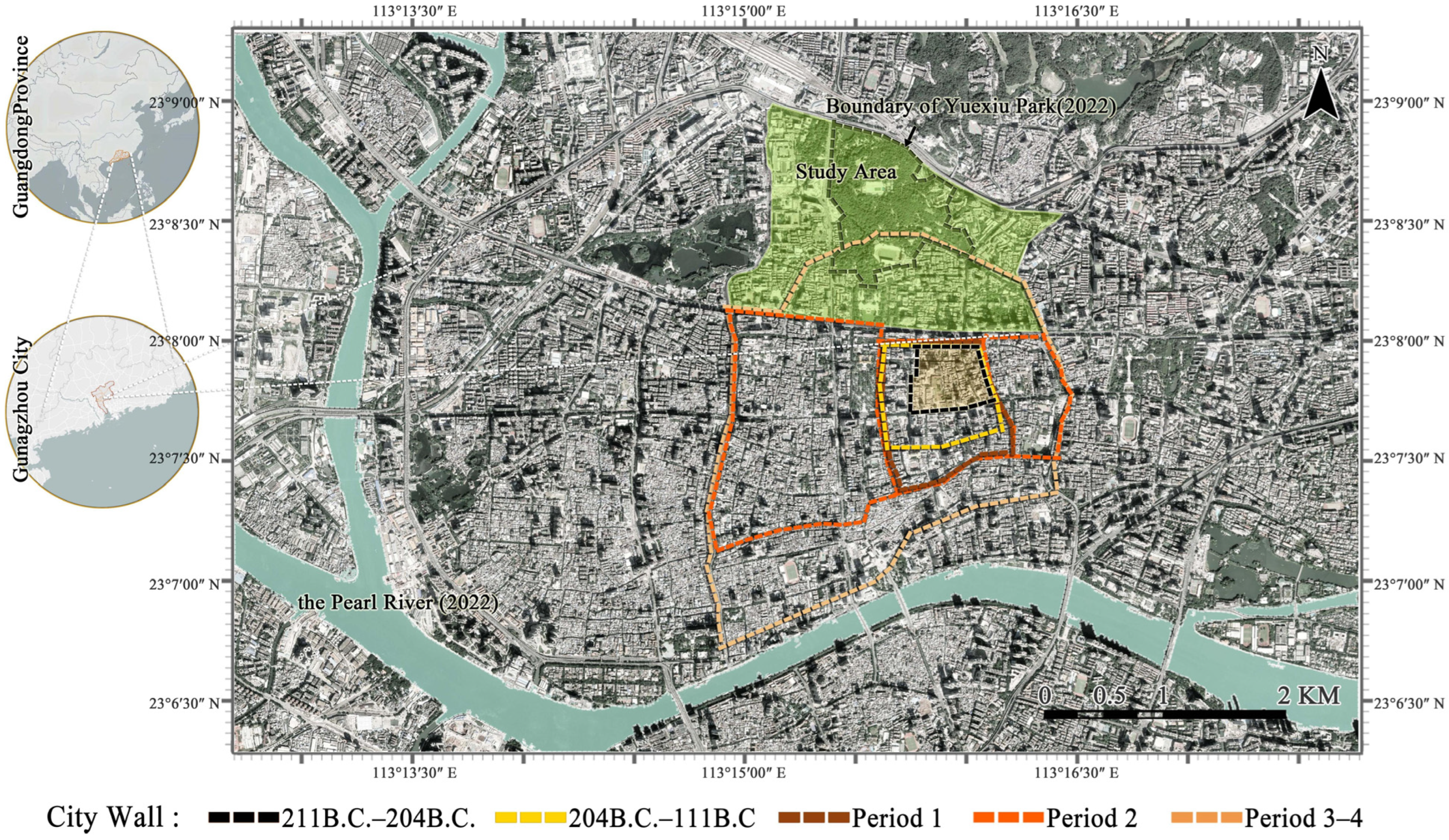
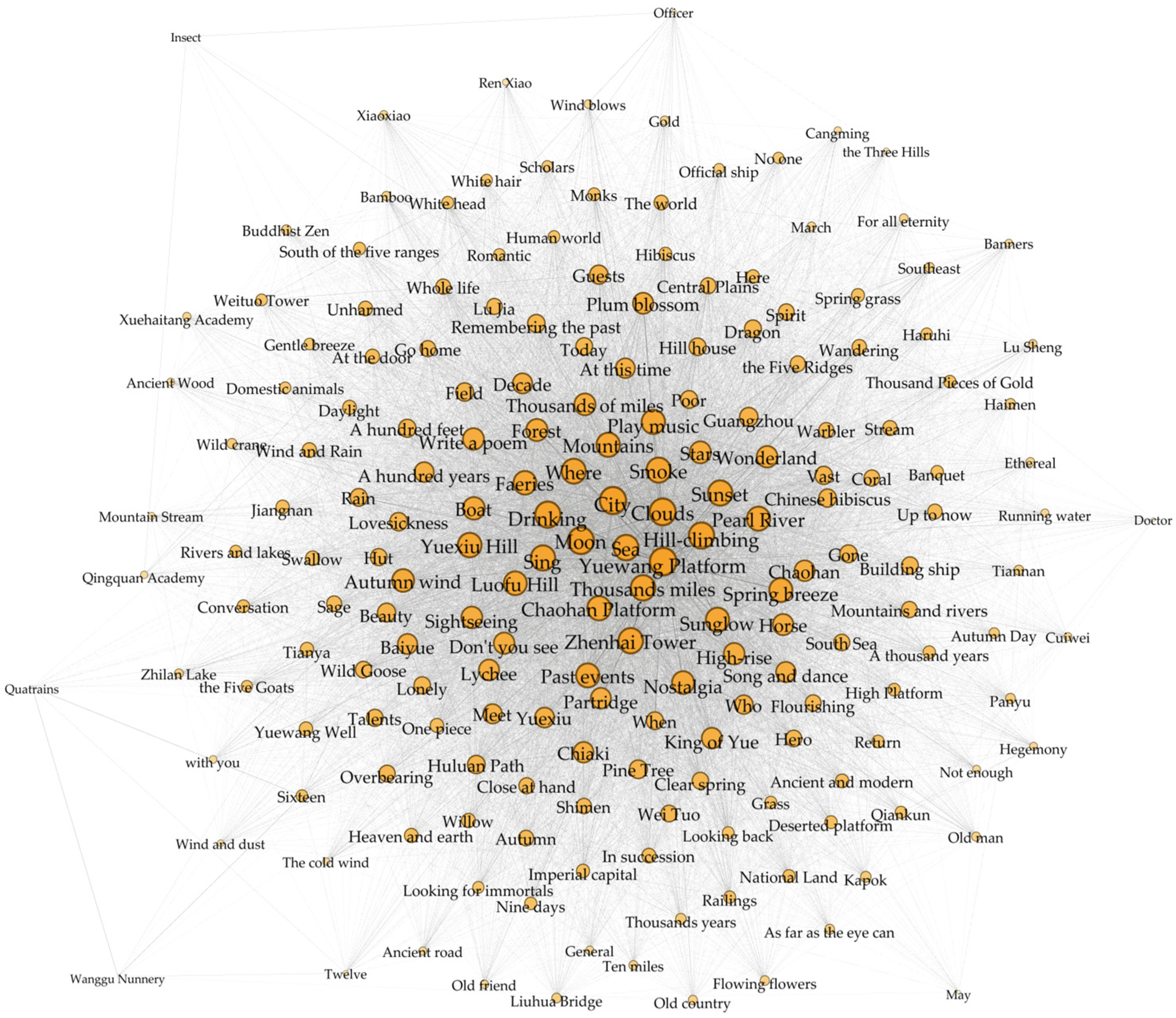
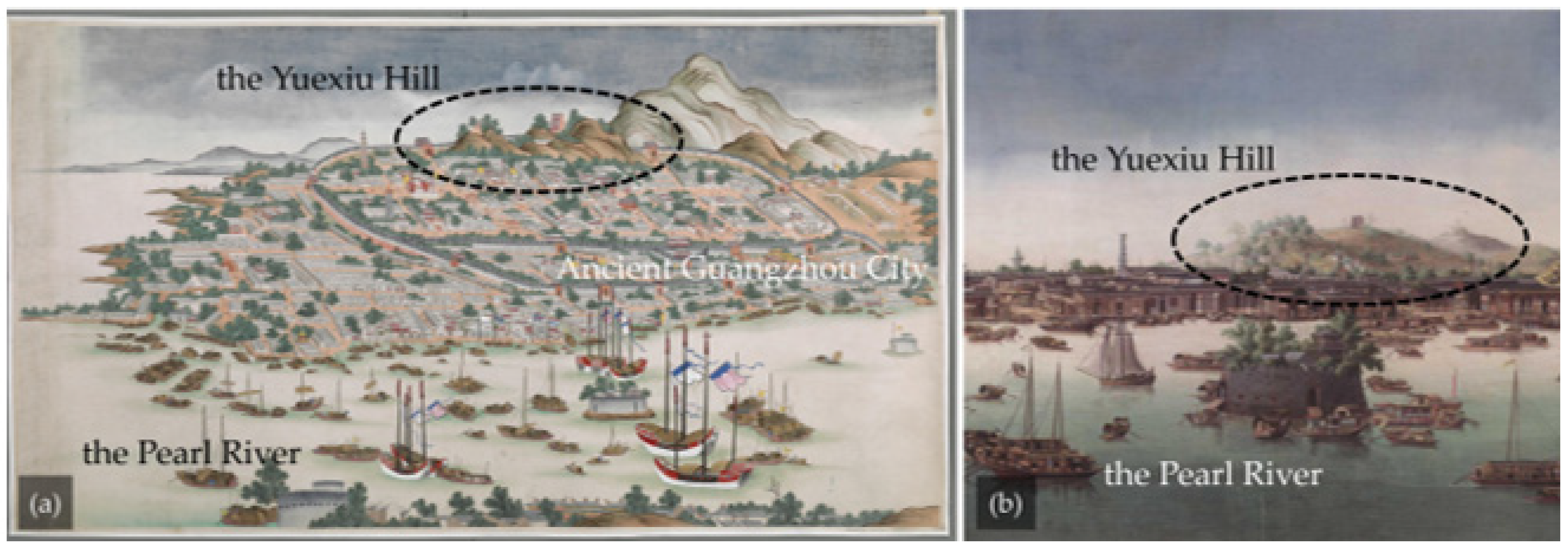
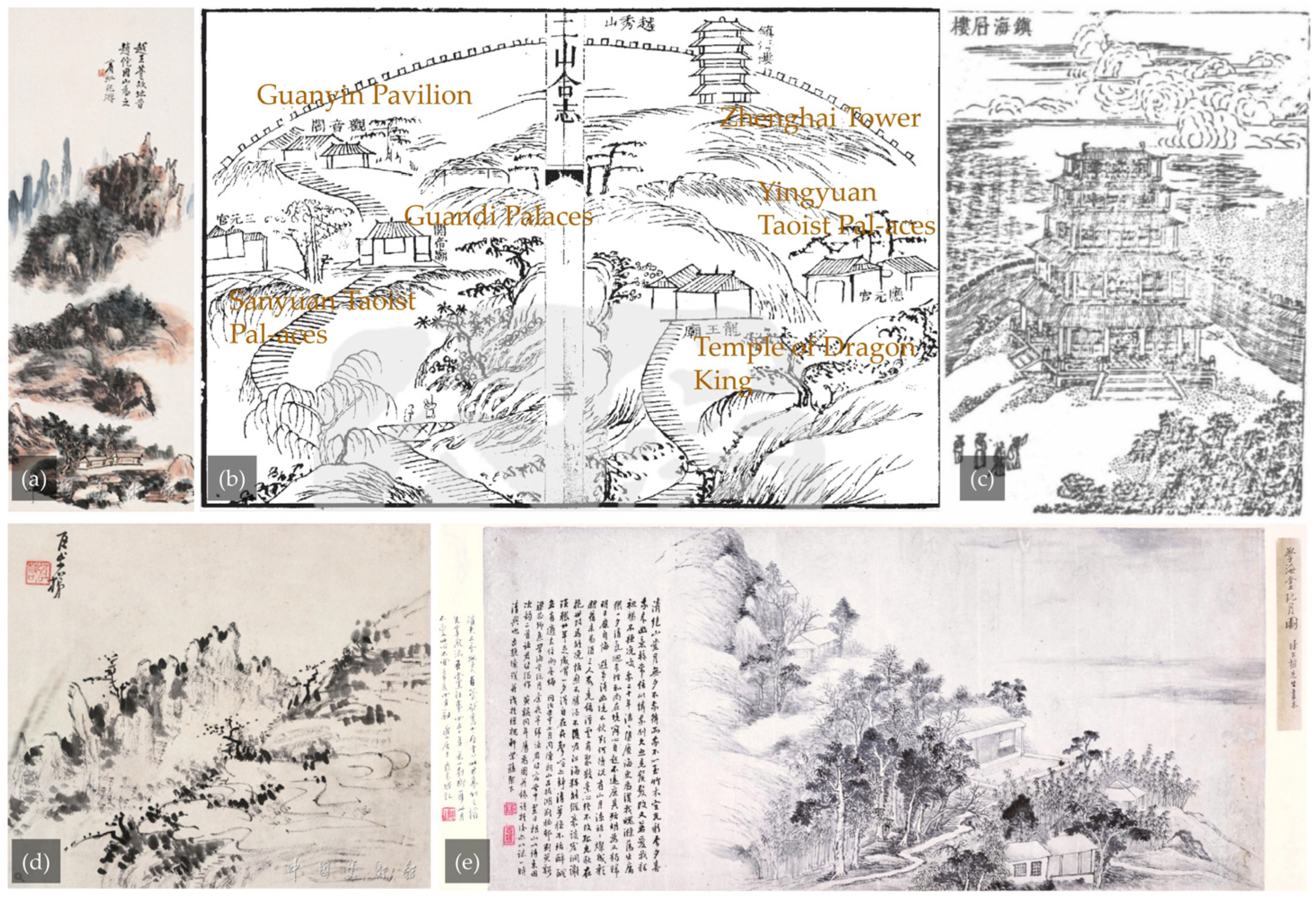
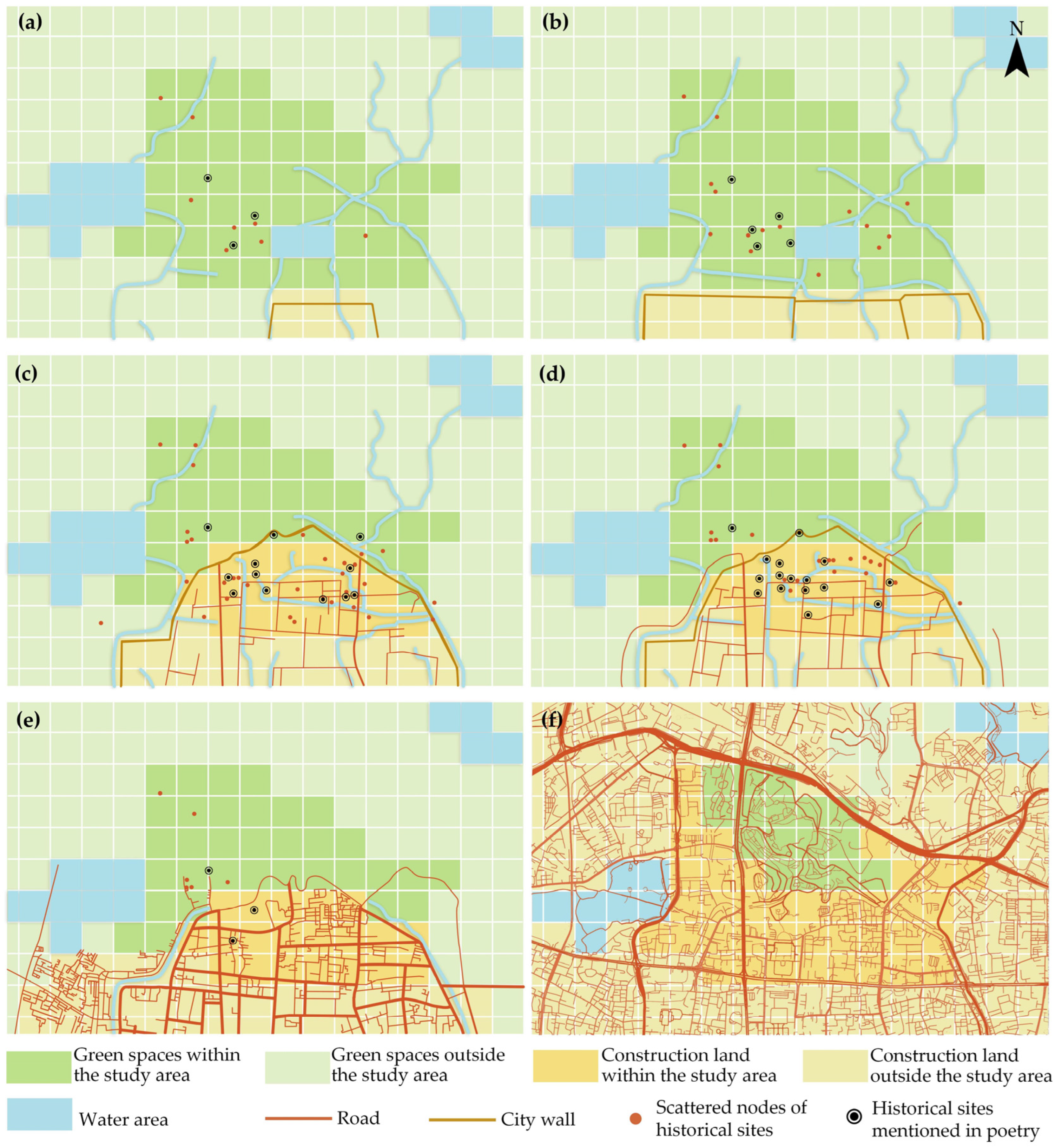
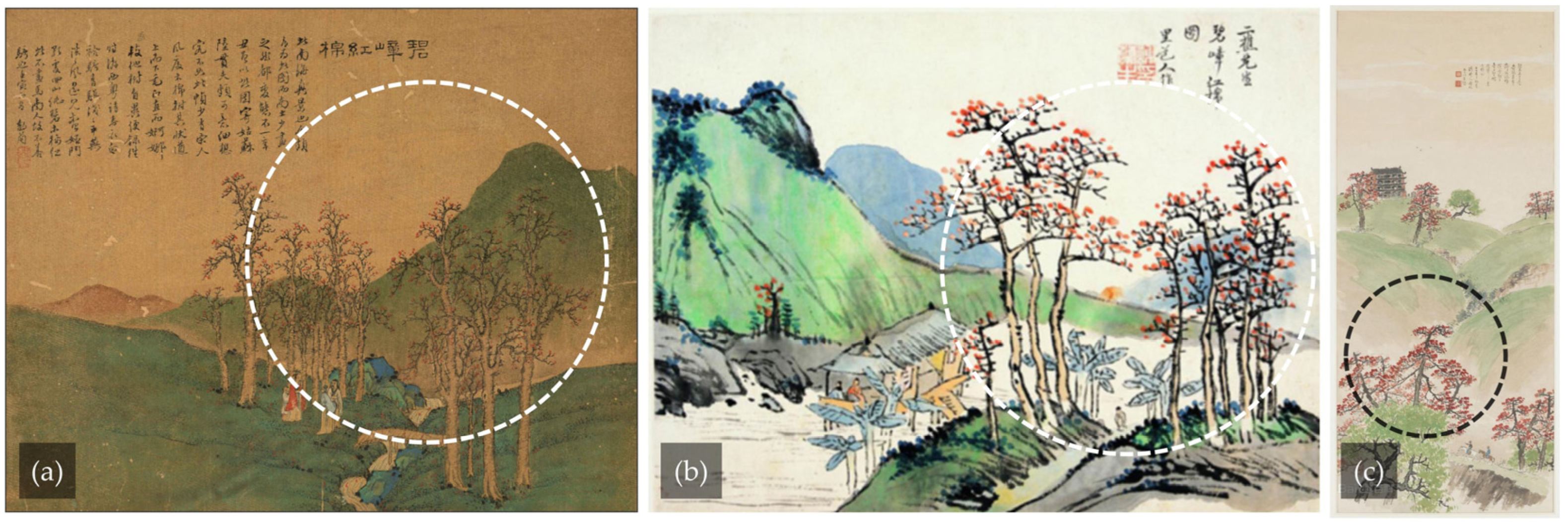
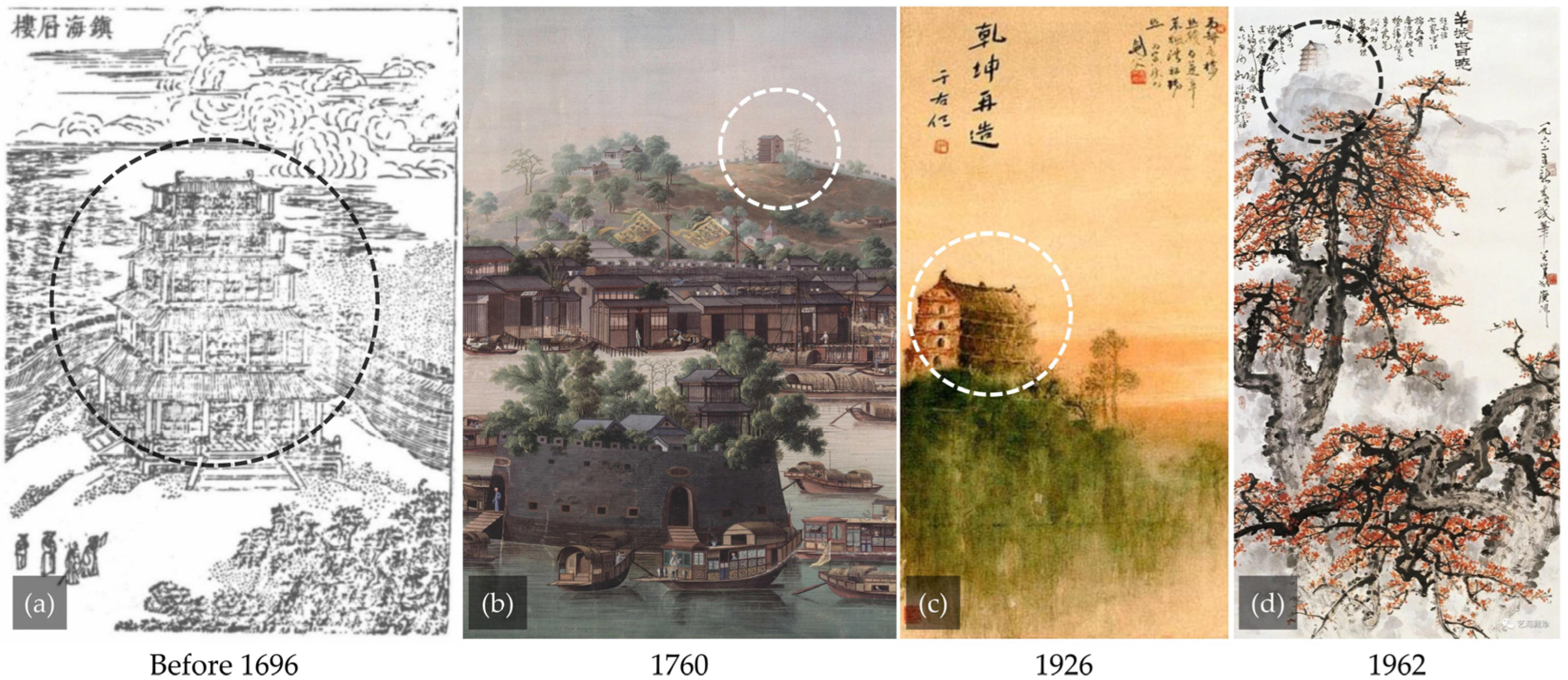
| Information Service | Standard Phrase | f | Value | Information Service | Standard Phrase | f | Value |
|---|---|---|---|---|---|---|---|
| Social relationships | Farewell | 10 | 153 | Artistic inspiration | poet | 5 | 66 |
| Have a conversation | 17 | Compose poems | 39 | ||||
| Banquet | 16 | Paint a picture | 18 | ||||
| Drink | 75 | Calligraphy | 4 | ||||
| Having tea | 4 | Education | Classical academy | 13 | 52 | ||
| Recreation and ecotourism | Hill-climbing | 129 | 328 | Academic studies | 22 | ||
| Go sightseeing | 46 | Gifted scholar | 17 | ||||
| Go fishing | 13 | Cultural memory | Nostalgia | 53 | 176 | ||
| Play music | 42 | Past events | 77 | ||||
| Singing and dancing | 98 | Festival | 3 | ||||
| Spiritual and religious | Meditation | 20 | 225 | Pure Brightness | 4 | ||
| Monks | 23 | Cold Food Day | 9 | ||||
| Journey to fairyland | 18 | The Double Ninth Festival | 7 | ||||
| Wonderland | 68 | The Lantern Festival | 10 | ||||
| Fairies | 71 | Worship the kitchen god | 2 | ||||
| Sages | 14 | Shangsi Festival | 1 | ||||
| Worship | 11 | Fly kite | 4 | ||||
| Dragon Boat Festival | 6 |
| Historic Sites | Artificial Elements | Historic Figures | Natural Meteorology | Celestial Objects | Animal Species | Plant Species | Waterscape Elements | Associated Regions | ||
|---|---|---|---|---|---|---|---|---|---|---|
| SR | WSR-j | 360 | 112 | 78 | 366 | 160 | 158 | 176 | 70 | 472 |
| PCTSR-j (%) | 18.44 | 5.74 | 4 | 18.75 | 8.2 | 8.09 | 9.02 | 3.59 | 24.18 | |
| RE | WRE-j | 800 | 338 | 114 | 772 | 350 | 300 | 426 | 138 | 998 |
| PCTRE-j (%) | 18.89 | 7.98 | 2.69 | 18.22 | 8.26 | 7.08 | 10.06 | 3.26 | 23.56 | |
| AI | WAI-j | 106 | 42 | 28 | 114 | 60 | 48 | 58 | 24 | 140 |
| PCTAI-j (%) | 17.1 | 6.77 | 4.52 | 18.39 | 9.68 | 7.74 | 9.35 | 3.87 | 22.58 | |
| S and R | WS&R-j | 402 | 148 | 80 | 494 | 262 | 154 | 258 | 116 | 592 |
| PCTS&R-j (%) | 16.04 | 5.91 | 3.19 | 19.71 | 10.45 | 6.15 | 10.3 | 4.63 | 23.62 | |
| E | WE-j | 54 | 10 | 8 | 28 | 14 | 22 | 24 | 10 | 58 |
| PCTE-j (%) | 23.68 | 4.39 | 3.51 | 12.28 | 6.14 | 9.65 | 10.53 | 4.39 | 25.44 | |
| CM | WCM-j | 340 | 110 | 60 | 344 | 172 | 138 | 160 | 44 | 438 |
| PCTCM-j (%) | 18.83 | 6.09 | 3.32 | 19.05 | 9.52 | 7.64 | 8.86 | 2.44 | 24.25 | |
| Wj | 2062 | 760 | 368 | 2118 | 1018 | 820 | 1102 | 402 | 2698 | |
| PCTj (%) | 18.17 | 6.7 | 3.24 | 18.66 | 8.97 | 7.23 | 9.71 | 3.54 | 23.78 |
| SR | RE | AI | S and R | E | CM | ||||||||||||||
|---|---|---|---|---|---|---|---|---|---|---|---|---|---|---|---|---|---|---|---|
| Drink | Have a conversation | Banquet | Song and dance | Go sightseeing | Song and dance | Play music | Hill-climbing | Compose poems | Fairies | Wonderland | Monks | Journey to Fairyland | Meditation | Sages | Gifted scholar | Past events | Nostalgia | ||
| SR | Drink | - | |||||||||||||||||
| Have a conversation | 12 | - | |||||||||||||||||
| Banquet | 2 | - | - | ||||||||||||||||
| RE | Song and dance | 44 | 8 | 12 | - | ||||||||||||||
| Go sightseeing | 30 | 6 | 4 | 22 | - | ||||||||||||||
| Song and dance | 20 | - | 6 | 16 | 8 | - | |||||||||||||
| Play music | 44 | - | 8 | 16 | 16 | 10 | - | ||||||||||||
| Hill-climbing | 32 | 10 | 12 | 38 | 14 | 24 | 32 | - | |||||||||||
| AI | Compose poems | 32 | 4 | 2 | 20 | 12 | 12 | 8 | 20 | - | |||||||||
| S and R | Fairies | 22 | 14 | 14 | 12 | 18 | 20 | 10 | 28 | 22 | - | ||||||||
| Wonderland | 20 | 8 | 8 | 12 | 12 | 16 | 20 | 22 | 22 | 30 | - | ||||||||
| Monks | 6 | - | - | 10 | 16 | 4 | 2 | 10 | 16 | 4 | 6 | - | |||||||
| Journey to Fairyland | 8 | - | 2 | 10 | 8 | 6 | 8 | 10 | 8 | 10 | 12 | - | - | ||||||
| Meditation | 2 | - | 2 | 4 | 2 | - | 2 | 6 | 2 | 6 | 6 | 6 | 4 | - | |||||
| Sages | 4 | 4 | 4 | 4 | 8 | - | 6 | 6 | 8 | 32 | 18 | 4 | 6 | - | - | ||||
| E | Gifted scholar | 4 | 6 | - | 8 | 6 | 4 | - | 4 | 4 | 2 | - | - | - | - | 6 | - | ||
| CM | Past events | 28 | 4 | 6 | 18 | 14 | 24 | 18 | 8 | 18 | 16 | 24 | 16 | 10 | 6 | 8 | 16 | - | |
| Nostalgia | 38 | - | 4 | 12 | 12 | 10 | 36 | 32 | 12 | 10 | 16 | - | 4 | - | 10 | 4 | 30 | - | |
Disclaimer/Publisher’s Note: The statements, opinions and data contained in all publications are solely those of the individual author(s) and contributor(s) and not of MDPI and/or the editor(s). MDPI and/or the editor(s) disclaim responsibility for any injury to people or property resulting from any ideas, methods, instructions or products referred to in the content. |
© 2023 by the authors. Licensee MDPI, Basel, Switzerland. This article is an open access article distributed under the terms and conditions of the Creative Commons Attribution (CC BY) license (https://creativecommons.org/licenses/by/4.0/).
Share and Cite
Gao, W.; Wang, S.; Chen, S.; Hu, S.; Li, H. Identifying Cultural Ecosystem Services and Relevant Landscape Elements Provided by Urban Green Space throughout History from an Information Communication Perspective. Forests 2023, 14, 1045. https://doi.org/10.3390/f14051045
Gao W, Wang S, Chen S, Hu S, Li H. Identifying Cultural Ecosystem Services and Relevant Landscape Elements Provided by Urban Green Space throughout History from an Information Communication Perspective. Forests. 2023; 14(5):1045. https://doi.org/10.3390/f14051045
Chicago/Turabian StyleGao, Wei, Siyou Wang, Shaotao Chen, Shengjie Hu, and Hui Li. 2023. "Identifying Cultural Ecosystem Services and Relevant Landscape Elements Provided by Urban Green Space throughout History from an Information Communication Perspective" Forests 14, no. 5: 1045. https://doi.org/10.3390/f14051045
APA StyleGao, W., Wang, S., Chen, S., Hu, S., & Li, H. (2023). Identifying Cultural Ecosystem Services and Relevant Landscape Elements Provided by Urban Green Space throughout History from an Information Communication Perspective. Forests, 14(5), 1045. https://doi.org/10.3390/f14051045






